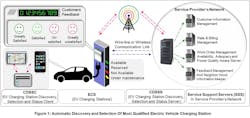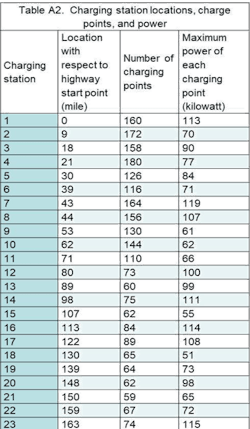The global electric vehicle (EV) charging infrastructure market size is expected to reach US$63.9 billion by 2025. However, EVs still face a big hurdle in the form of charging systems. Because of the prevailing scarcity of charging stations, finding EV charging stations (ECS), and more specifically, finding the most qualified ECS that meets an EV driver's requirements may be an overwhelming task.
Despite charging station providers publishing online directories, web-based Google map assisted locators, online hours of operations, and so forth, in today's technology and age, these methods are not proficient because they do not help EV drivers discover and select that one ECS that meets their dynamically changing charging needs. Even more so, since EV charging could have a substantial impact on the grid at certain times of the day and locations, assuring adequacy and quality of power supply 24x7 will be a daunting task for electric utility companies and charging service infrastructure providers. For instance, it will be frustrating for an EV driver to reach a certain location and not find the service and the value he was looking for, because of diversified reasons:
- The grid at that time and location is running at peak load and does not have adequate capacity to charge multiple EVs and hence has high tariff
- The neighborhood at that time and location is not safe or does not offer gender-specific safety
- Unreasonable long waiting times, since charging a single EV may take at least 30 minutes to 6 hours
- Terrible user experience because of poor charging service, poor power quality, and poor customer service
- Negligible value for money
Proposed technology
To address the above issue, this article introduces a method and apparatus based on which the software/hardware client installed in vehicles would automatically discover, shortlist, and select or recommend to an EV driver the most qualified ECS. The selection of the most qualified ECS is based on several factors like:
- The vehicle's current location
- The ECS' current status (such as vacant, in use, or under maintenance)
- Availability (that is, adequacy and quality of power from the grid at that time)
- Available charging levels at the ECS (such as level-1, level-2, level-3)
- Charging experience (based on previous user reviews and feedback)
- Neighborhood safety (that is, safe or vulnerable, and gender-based safety)
- Pricing (based on-peak/off-peak demand, ongoing promotions, special deals/coupons, and so forth)
Some or all of the above noted qualifying credentials may be set in the proposed client once and forever, updated when desired, and altered by an EV driver based on his preferences, priorities, or day-to-day primacies. The software client installed in vehicles is also capable of automatically feeding the civic address of the most qualified ECS to the GPS installed on the mobile device over Bluetooth with or without the EV driver's intervention, thus offering a fully-automated system. To achieve an "automatic discovery and selection of the most qualified ECS," the overall system consists of the following components:
- ECS with enhanced capabilities: While ECSs already exist in the field, we propose some enhancements in accordance with the proposed system.
- EV Charging Station Discovery, Selection, and Status Server (CDSSS): The CDSSS is a server in the service provider's network. It plays a vital role as it communicates with three key players, that is, the utility company, the charging station discovery, selection and status client (CDSSC) installed in the EV or the EV driver's mobile device as an app to convey the EV driver's requirements), and ECSs in the field. Thus, it knows the utility's supply adequacy, EV drivers' preferences, and the status of ECSs in the field on a real-time basis, as shown in Figure 2. Therefore, it is the best three-way matchmaker to propose the most qualified ECS to an EV driver.
- EV Charging Station Discovery, Selection, and Status Client (CDSSC): The CDSSC may be an app installed on the mobile phone, or a hardware/software entity that resides in the vehicle and provides a communication interface to the EV driver.
- Service support servers: These reside in the utility company's network.
The CDSSS communicates with the ECSs in the field over a wireless or wireline communication link, with the CDSSC over a wireless 4G/5G communication interface, and the service support servers — that may be in the service provider’s network or on the cloud — on any state-of-the-art communication technologies. The overall concept is depicted in Figure 1.
Test problem setup
In the following test scenarios, the one-way traffic along a 310-mile long highway is considered, which has 18 ingress and egress points for vehicle entry and exit to the highway. The 18 ingress and egress points include the start (zero-mile point) and the end (310-mile point) of the highway. At any time during the 24-hour simulation session considered here, vehicles may enter and exit the highway through any one of the 18 points. Any vehicle that enters the highway is assigned an intended destination, which is one of the egress points between the vehicle's entrance point and the end of the highway. In this simulation, on an average, 50% of the vehicles that entered the highway continued all the way to the endpoint regardless of the entry point into the highway.
Table A1 lists the locations of all the entrance and exit points along the highway and the normalized traffic volumes entering the highway through each of the entrance points. There are 43 charging stations distributed along the highway. Table A2 (truncated for space), lists the locations of charging stations, the number of charge points at each charging station and the charge point power rating at each charging station. The total number of charge points is 3925 and all the charge points in a particular charging station have the same power rating. It is seen from Table A2 that minimum and maximum charge point power ratings are, respectively, 19 kW and 46 kW. When a vehicle is connected to a charge point, the intake (supplied) power is the smaller of the charge point power rating and the power rating of the vehicle's charging system.
Simulation results
The results obtained (not presented here) pertain to a 24-hour simulation session that started at 5 a.m. and ended at the same time on the following day. The results pertain to the total power supplied by the charging stations (intake) and consumed by all the vehicles as a function of time when CS-AIS was activated and deactivated; the effect of CS-AIS on vehicles’ normalized effective speed, the number of vehicles moving, charging, and waiting in charging queues as a function of time when CS-AIS was activated and deactivated; the effect of CS-AIS on the number of vehicles arriving at their intended destinations as a function of time; charging station availability quotients (CSAQ) of 43 charging stations as functions of time when CS-AIS was activated and deactivated; distribution of length of vehicles’ charging sessions when CS-AIS was activated and deactivated; and the effect of CS-AIS on the overall charge point use factor, and so forth.
The results show that the proposed technology overcomes the shortcomings, limitations, and challenges of finding the most qualified charging station.
About the Author
Raziq Yaqub
Dr. Yaqub is an associate professor in the Department of Electrical Engineering and Computer Science, Alabama A&M University. He is also supervising the research activities of Amphenol-Tecvox Corp. as a Director of Global R&D. He earned a PhD in Wireless Communication from Keio University, Japan, and an MBA in Marketing from Fairleigh Dickinson University, USA. He is an inventor of numerous technologies and has filed dozens of patents in Wireless Communication, Smart Grid, and Cybersecurity of Fin-Tech. He received an Inventor of the Year Award 2014 from New Jersey Inventors Hall of Fame. He also received an Innovator Young Faculty Award 2019 from his University. He has served as executive director of Toshiba America Research and as the department head of NIKSUN University, Princeton, NJ, to lead cybersecurity and big data analytics. He has also served as a senior consultant to the State of New Jersey, a spokesperson in 3GPP on behalf of the Department of Homeland Security, an expert inventor with Wells Fargo, and an associate professor at the University of Tennessee, Chattanooga, USA. He is a senior member of IEEE. More about the author can be found here.




